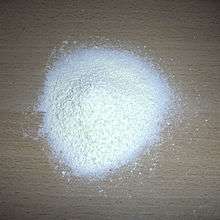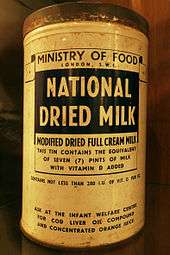Powdered milk

Powdered milk or dried milk is a manufactured dairy product made by evaporating milk to dryness. One purpose of drying milk is to preserve it; milk powder has a far longer shelf life than liquid milk and does not need to be refrigerated, due to its low moisture content. Another purpose is to reduce its bulk for economy of transportation. Powdered milk and dairy products include such items as dry whole milk, nonfat (skimmed) dry milk, dry buttermilk, dry whey products and dry dairy blends. Many dairy products exported conform to standards laid out in Codex Alimentarius. Many forms of milk powder are traded on exchanges.
Powdered milk is used for food and health (nutrition), and also in biotechnology[1] (saturating agent).
History and manufacture

While Marco Polo wrote of Mongolian Tatar troops in the time of Kublai Khan who carried sun-dried skimmed milk as "a kind of paste",[2] the first modern production process for dried milk was invented by the Russian physician Osip Krichevsky in 1802.[3] The first commercial production of dried milk was organized by the Russian chemist M. Dirchoff in 1832. In 1855, T.S. Grimwade took a patent on a dried milk procedure,[4] though a William Newton had patented a vacuum drying process as early as 1837.[5]
In modern times, powdered milk is usually made by spray drying[6] nonfat skimmed milk, whole milk, buttermilk or whey. Pasteurized milk is first concentrated in an evaporator to approximately 50% milk solids. The resulting concentrated milk is then sprayed into a heated chamber where the water almost instantly evaporates, leaving fine particles of powdered milk solids.
Alternatively, the milk can be dried by drum drying. Milk is applied as a thin film to the surface of a heated drum, and the dried milk solids are then scraped off. However, powdered milk made this way tends to have a cooked flavor, due to caramelization caused by greater heat exposure.
Another process is freeze drying, which preserves many nutrients in milk, compared to drum drying.
The drying method and the heat treatment of the milk as it is processed alters the properties of the milk powder, such as its solubility in cold water, its flavor, and its bulk density.
Food and health uses

Powdered milk is frequently used in the manufacture of infant formula, confectionery such as chocolate and caramel candy, and in recipes for baked goods where adding liquid milk would render the product too thin. Powdered milk is also widely used in various sweets such as the famous Indian milk balls known as gulab jamun and a popular Indian sweet delicacy (sprinkled with desiccated coconut) known as Chum chum (made with skim milk powder).
Powdered milk is also a common item in UN food aid supplies, fallout shelters, warehouses, and wherever fresh milk is not a viable option. It is widely used in many developing countries because of reduced transport and storage costs (reduced bulk and weight, no refrigerated vehicles). Like other dry foods, it is considered nonperishable, and is favored by survivalists, hikers, and others requiring nonperishable, easy-to-prepare food.
Because of its resemblance to cocaine and other drugs, powdered milk is sometimes used in filmmaking as a non-toxic prop that may be insufflated.
Reconstitution
The weight of nonfat dry milk (NFDM) to use is about 10% of the water weight.[7][note 1] Alternatively, one cup of potable fluid milk from powdered milk requires one cup of potable water and one-third cup of powdered milk.
Nutritional value
Milk powders contain all twenty-one standard amino acids, the building blocks of proteins, and are high in soluble vitamins and minerals.[8] According to USAID,[9] the typical average amounts of major nutrients in the unreconstituted nonfat dry milk are (by weight) 36% protein, 52% carbohydrates (predominantly lactose), calcium 1.3%, potassium 1.8%. Whole milk powder, on the other hand, contains on average 25-27% protein, 36-38% carbohydrates, 26-40% fat, and 5-7% ash (minerals). However, inappropriate storage conditions such as high relative humidity and high ambient temperature can significantly degrade the nutritive value of milk powder.[10]
Commercial milk powders are reported to contain oxysterols (oxidized cholesterol)[11] in higher amounts than in fresh milk (up to 30 μg/g, versus trace amounts in fresh milk).[12] Oxysterols are derivatives of cholesterol that are produced either by free radicals or by enzymes. Some free radicals-derived oxysterols have been suspected of being initiators of atherosclerotic plaques.[13] For comparison, powdered eggs contain even more oxysterols, up to 200 μg/g.[12]
Export market

European production of milk powder is estimated around 800,000 tons of which the main volume is exported in bulk packing or consumer packs.
Brands on the market include "Nido", from the company Nestlé, "Incolac" from the company Belgomilk, and "Dutch Lady" from FrieslandCampina.
Adulteration
In the 2008 Chinese milk scandal, melamine adulterant was found in Sanlu infant formula, added to fool tests into reporting higher protein content. Thousands became ill, and some children died, after consuming the product.
In August 2013, China temporarily suspended all milk powder imports from New Zealand, after a scare where botulism-causing bacteria was falsely detected in several batches of New Zealand-produced whey protein concentrate. As a result of the product recall, the New Zealand dollar slipped significantly based on expected losses in sales from this single commodity.[14]
Use in biotechnology
Fat-free powdered milk is used as a saturating agent to block nonspecific binding sites on supports like blotting membranes (nitrocellulose, polyvinylidene fluoride (PVDF) or nylon),[15] preventing binding of further detection reagents and subsequent background.[16] It may be referred as Blotto. The major protein of milk, casein, is responsible for most of the binding site saturation effect.
See also
Notes
- ↑ Gisslen wrote, "910 g water + 90 g nonfat dry milk" ⟹ 90
g/910g≈ 0.0989 = 9.89%. Gisslen also wrote, "14.5 oz water + 1.5 oz nonfat dry milk" ⟹ 1.5oz/14.5oz≈ 0.1034 = 10.34%. There's a value range, depending on weight system used, of 9.89-10.34% NFDM based on water weight when reconstituting nonfat or skim milk.
References
- ↑ Buffers & Saturating agents http://www.interchim.fr/ft/B/BA352a.pdf Retrieved 2014 July 16
- ↑ p. 262 in "The Book of Ser Marco Polo, Book 1" translated by Sir Henry Yule (3rd edition), Charles Scribner's Sons, New York, 1903
- ↑ В Рязани производят кошерное сухое молоко [Kosher Milk is Produced in Ryazan]. Наша Рязань (in Russian). 16 February 2010. Retrieved 22 April 2013.
- ↑ p 277 in "Condensed Milk and Milk Powder, 3rd edition" authored and published by O.F. Hunziker, 1920
- ↑ p 318 in "Foods: Their Composition and Analysis: A Manual for the Use of Analytical Chemists and Others" by A.W. Blyth, published by C. Griffin, 1896 https://archive.org/details/foodstheircompos00blyt
- ↑ "Milk Powder" by K.N. Pearce, Food Science Section, New Zealand Dairy Research Institute. nzic.org.nz
- ↑ Wayne Gisslen (2009). Professional Baking (5th ed.). Hoboken, N.J.: John Wiley. p. 77. ISBN 0-471-78349-8. Retrieved May 18, 2011.
- ↑ Milk Powder Nutritional Information, US Dairy Export Council
- ↑ USAID Commodities Reference Guide, Non Fat Dry Milk, USAID, Jan 2006, archived from the original on Feb 29, 2012
- ↑ M. Okamoto and R. Hayashi (1985) "Chemical and Nutritional Changes of Milk Powder Proteins under Various Water Activities" Agric. Biol. Chem., Vol.49 (6), pp 1683-1687.
- ↑ p 655 in "Advanced Dairy Chemistry: Volume 2 - Lipids" by P.F. Fox and P. McSweeney, Birkhäuser, 2006 ISBN 978-0-387-26364-9
- 1 2 p 296 in "Toxins in Food" by W.M. Dabrowski and Z.E. Sikorski, CRC Press, 2004, ISBN 978-0-8493-1904-4
- ↑ RHubbard, RW; Ono, Y; Sanchez, A (1989). "Atherogenic effect of oxidized products of cholesterol". Progress in food & nutrition science. 13 (1): 17–44. PMID 2678267.
- ↑ Kiwi sinks on milk-powder ban as most Asian stock futures climb The Associated Press, Aug 2013
- ↑ Technical sheet #768701, from Interchim
- ↑ p 82 in "Lab Ref, Volume 2: A Handbook of Recipes, Reagents, and Other Reference Tools for Use at the Bench" by A.S. Mellick and L. Rodgers, CSHL Press, 2002, ISBN 978-0-87969-630-6
External links
| Wikimedia Commons has media related to Powdered milk. |